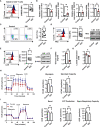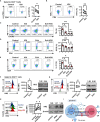Iguratimod Restrains Circulating Follicular Helper T Cell Function by Inhibiting Glucose Metabolism via Hif1α-HK2 Axis in Rheumatoid Arthritis
- PMID: 35720293
- PMCID: PMC9199372
- DOI: 10.3389/fimmu.2022.757616
Iguratimod Restrains Circulating Follicular Helper T Cell Function by Inhibiting Glucose Metabolism via Hif1α-HK2 Axis in Rheumatoid Arthritis
Abstract
Iguratimod (IGU) is a novel disease modified anti-rheumatic drug, which has been found to act directly on B cells for inhibiting the production of antibodies in rheumatoid arthritis (RA) patients. Follicular helper T (Tfh) cells, a key T cell subsets in supporting B cell differentiation and antibody production, have been shown to play critical roles in RA. However, whether IGU can inhibit RA Tfh cells which further restrains B cell function remains unclear. Here, we aimed to explore the roles of IGU in regulating RA circulating Tfh (cTfh) cell function and investigate the potential mechanism associated with cell glucose metabolism. In our study, we found that IGU could act on RA-CD4+ T cells to reduce T cell-dependent antibody production. IGU decreased the percentage of RA cTfh cells and the expression of Tfh cell-related molecules and cytokines which were involved in B cell functions. Importantly, our data showed that IGU significantly restrained the cTfh cell function by inhibiting glucose metabolism, which relied on Hif1α-HK2 axis. In summary, we clarified a new target and mechanism of IGU by restraining RA cTfh cell function via inhibiting Hif1α-HK2-glucose metabolism axis. Our study demonstrates the potential application of IGU in the treatment of diseases related to abnormal metabolism and function of Tfh cells.
Keywords: Hif1α-HK2 axis; circulating follicular helper T cells; glucose metabolism; iguratimod; rheumatoid arthritis.
Copyright © 2022 Bai, Lu, Liu, Tang, Ye, Jin, Wang and Li.
Conflict of interest statement
The authors declare that the research was conducted in the absence of any commercial or financial relationships that could be construed as a potential conflict of interest.
Figures






Similar articles
-
Exploring the differential functions of circulating follicular helper T and peripheral helper T cells in rheumatoid arthritis based on metabolism patterns.Front Immunol. 2025 Jun 17;16:1608675. doi: 10.3389/fimmu.2025.1608675. eCollection 2025. Front Immunol. 2025. PMID: 40599793 Free PMC article.
-
Interleukin-29 regulates T follicular helper cells by repressing BCL6 in rheumatoid arthritis patients.Clin Rheumatol. 2020 Dec;39(12):3797-3804. doi: 10.1007/s10067-020-05151-y. Epub 2020 May 28. Clin Rheumatol. 2020. PMID: 32468318
-
Iguratimod dose dependently inhibits the expression of citrullinated proteins and peptidylarginine deiminases 2 and 4 in neutrophils from rheumatoid arthritis patients.Clin Rheumatol. 2020 Mar;39(3):899-907. doi: 10.1007/s10067-019-04835-4. Epub 2019 Nov 22. Clin Rheumatol. 2020. PMID: 31758423
-
Iguratimod as a New Drug for Rheumatoid Arthritis: Current Landscape.Front Pharmacol. 2020 Feb 26;11:73. doi: 10.3389/fphar.2020.00073. eCollection 2020. Front Pharmacol. 2020. PMID: 32174824 Free PMC article. Review.
-
Follicular helper T cells: potential therapeutic targets in rheumatoid arthritis.Cell Mol Life Sci. 2021 Jun;78(12):5095-5106. doi: 10.1007/s00018-021-03839-1. Epub 2021 Apr 20. Cell Mol Life Sci. 2021. PMID: 33880615 Free PMC article. Review.
Cited by
-
Iguratimod suppresses Tfh cell differentiation in primary Sjögren's syndrome patients through inhibiting Akt/mTOR/STAT3 signaling.Arthritis Res Ther. 2023 Aug 22;25(1):152. doi: 10.1186/s13075-023-03109-4. Arthritis Res Ther. 2023. PMID: 37608388 Free PMC article.
-
Hexokinase2-engineered T cells display increased anti-tumor function.Front Immunol. 2025 Mar 20;16:1477929. doi: 10.3389/fimmu.2025.1477929. eCollection 2025. Front Immunol. 2025. PMID: 40181966 Free PMC article.
-
T follicular helper cells in primary immune regulatory disorders.J Allergy Clin Immunol. 2025 Jun 17:S0091-6749(25)00647-5. doi: 10.1016/j.jaci.2025.06.005. Online ahead of print. J Allergy Clin Immunol. 2025. PMID: 40553897 Review.
-
TLR2 reprograms glucose metabolism in CD4+ T cells of rheumatoid arthritis patients to mediate cell hyperactivation and TNF-α secretion.Clin Rheumatol. 2024 Nov;43(11):3537-3549. doi: 10.1007/s10067-024-07125-w. Epub 2024 Oct 2. Clin Rheumatol. 2024. PMID: 39356380
-
An update on the use of conventional and biological disease-modifying anti-rheumatic drugs in hand osteoarthritis.Ther Adv Musculoskelet Dis. 2023 Mar 14;15:1759720X231158618. doi: 10.1177/1759720X231158618. eCollection 2023. Ther Adv Musculoskelet Dis. 2023. PMID: 36937821 Free PMC article. Review.
References
Publication types
MeSH terms
Substances
LinkOut - more resources
Full Text Sources
Medical
Research Materials

